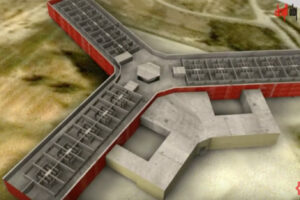Gaziantep- Turkey
A new report by the Association of Detainees and the Missing of Sednaya Prison (ADMSP) published today sheds light on the inner workings of the Syrian regime’s most notorious detention facility, Sednaya Military Prison, one of the most clandestine and well-guarded places in Syria.
The report details the prison’s chain of command for the first time, revealing those responsible for ordering and committing widespread and systematic torture and killings of detainees at Sednaya amounting to crimes against humanity. It also describes in meticulous detail the prison’s layout, defenses and administrative structure, showing how it has been deliberately fortified to repel external attacks and oppress detainees.
ADMSP’s report also reveals harrowing new details about the horrific treatment of prisoners at the prison, which has been described by Amnesty International as a “human slaughterhouse”. It estimates that more than 30,000 detainees were either executed or died as a result of torture, lack of medical care or starvation between 2011 and 2018 at Sednaya prison and highlights how special “salt chambers” were created to store dead bodies of victims. The regime is believed to have executed at least 500 further detainees between 2018 and 2021, according to survivor testimony.
“Our research aims to shed light on the leadership and inner workings of a facility that has become a notorious symbol of one of the bloodiest periods of Syrian history. For years horrifying crimes, including mass enforced disappearance, systematic torture and killings, have taken place inside Sednaya with total impunity and no justice in sight. We hope that this information provides a clearer picture of those in command and responsible for ordering these crimes, as well as clarifying the prison’s ties with state institutions could play an important role in holding accountable perpetrators of crimes against humanity within Syria’s detention system in future,” said Diab Serriya, co-founder of ADMSP who is also a former prisoner of Sednaya prison.
The report reveals how the prison is protected by three levels of security, with hundreds of guards stationed at various locations across the prison. The outer walls of the prison are protected by military police prison staff known as the exterior company and the Syrian army’s Third Division. They are the first line of defense to ward off external threats and stop prison breaks. Around 40-50 members of the 21st brigade secure the prison perimeter between the inner and outer walls. Separate units are responsible for securing the inner part of the prison and monitoring and disciplining detainees.
The prison is also surrounded by two minefields, one inner field consisting of anti-personnel mines and another outer field consisting of anti-tank mines. There is even a unit specifically tasked with monitoring all incoming and outgoing landline and wireless communications to the prison and surrounding area, in addition to all nearby radio communications.
The prison is located at the top of a hill in a mountainous region north of Damascus. Its total area is around 1.4 square kilometres – equivalent to 184 football stadiums – a space eight times larger than the combined area of all the international-standard-sized football stadiums in Syria.
“Sednaya prison is a death camp that has borne witness to heinous crimes against humanity, including mass killings of detainees, torture and other cruel and inhumane treatment. For detainees, each day of their life was a day of suffering and torment – from being tortured by sadistic guards to being starved, stripped of their clothes and deprived of health care. They expected to die at any moment. This report not only preserves the memory of their suffering but could also play a role in ensuring accountability for these crimes.,” said Shadi Haroun, a survivor of Sednaya prison and a Programme Manager at ADMSP.
So far, all accounts of Sednaya prison have been based on the testimony of former detainees lucky enough to survive their imprisonment there. This report is unique in that it is based on 31 interviews, mainly with former prison staff who have defected, including some who held prominent positions at the prison.
The report also sheds light on the prison’s organizational structure and its ties to security apparatus, courts, the Ministry of Defense, and other state institutions. The authorities responsible for perpetrating crimes have ties with the Military Field Court and Syrian Intelligence Branch 227 and Branch 293. Sednaya’s links to official courts and institutions of the Syrian regime have allowed it to maintain a veneer of legal legitimacy despite the atrocities that have taken place there.
The report also highlights the role of Tishreen Military hospital in the disposal of detainees’ dead bodies following executions. Staff from the hospital transferred bodies in refrigerated “meat trucks” to be buried in mass graves. The bodies of detainees tortured to death or who died due to sickness or starvation were left in prison cells for up to 48 hours before being transferred to the “salt rooms” with just a number written on their foreheads. These bodies were then transported to Tishreen Military hospital who examined the body, issued a death certificate and sent the bodies for burial. Families never received the bodies of their loved ones.
Those executed were sentenced to death by military field courts in summary trials often lasting just minutes, in violation of international fair trials standards and cannot be considered legitimate judicial proceedings.
ENDS
For more information and for interviews requests, please contact: [email protected]






